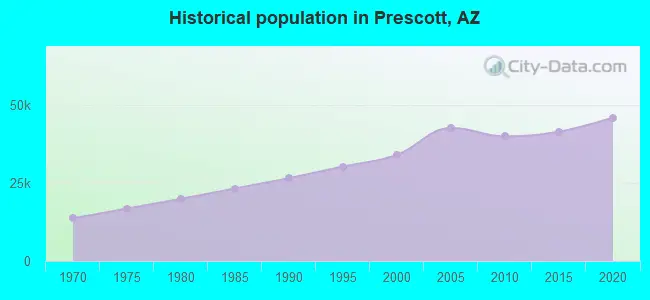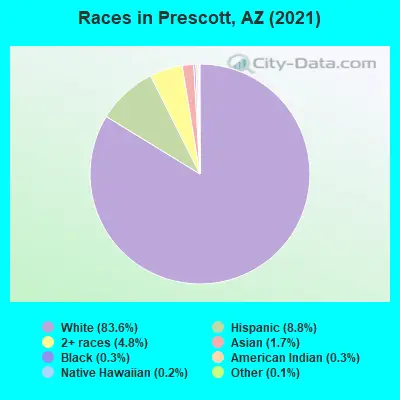The vibrant city of Prescott has undergone remarkable transformations over the decades, marked by shifts in its population demographics. This comprehensive article explores the captivating tale of the “Changes in Prescott’s population demographics over the decades”.

From the bustling heart of Arizona, Prescott’s demographic changes provide insights into the city’s evolution and future direction.
Prescott’s rich history and dynamic future are intricately intertwined with its demographic changes. Founded in 1864, the city has grown from a frontier settlement into a thriving urban center with a diverse populace. This article delves deep into the city’s demographic changes across multiple decades, providing an enriching perspective on the city’s evolving identity.
Understanding demographic trends is pivotal to comprehending the societal shifts and economic trends of a city. Appreciating Prescott’s demographics not only provides insights into its past but also allows us to anticipate future trends, influencing public policy, urban development, and economic strategies.
Historical Overview of Prescott
Established during the Civil War, Prescott’s history is colored by an array of influences. Its early years were shaped by gold mining activities, military establishments, and the native Yavapai tribe, which significantly influenced the initial population distribution.
Major events, such as the territorial capital relocation and the Great Depression, had profound effects on Prescott’s population growth and distribution. The city’s resilience in the face of challenges was evident as it continually adapted and thrived, underlining the city’s dynamic nature.
Demographic Changes: 1960 – 1980
In the pivotal years from 1960 to 1980, Prescott underwent significant demographic shifts that helped shape its future. This period saw a substantial influx of new residents, resulting in a more than doubling of the city’s population.
The majority of these new citizens were migrants, attracted by burgeoning opportunities in Prescott’s expanding industries, including manufacturing and services. Concurrently, Prescott began to see a growing number of retirees, attracted by the city’s idyllic climate and renowned quality of life. Alongside these changes in age distribution, Prescott also became more ethnically diverse.
The Hispanic and Native American populations started to increase during these decades, adding to the cultural richness of the city. This period also marked notable improvements in education levels, influenced in part by the establishment of Yavapai College in 1968, which opened up new opportunities for higher education in the city.
Population Growth and Migration
The 1960s and 70s witnessed substantial population growth in Prescott, spurred by post-war economic development and the rise of new industries. The city’s population more than doubled, with migrants drawn by opportunities in sectors like manufacturing and services.
Prescott’s age distribution also transformed during these decades, seeing a growing number of retirees drawn by the pleasant climate and quality of life.
Cultural Diversity and Ethnic Shifts
Simultaneously, Prescott became more ethnically diverse, with an increasing number of Hispanic and Native American residents. This added a rich cultural tapestry to the city, influencing its social and cultural fabric.

Educational attainment levels also improved during these years. The establishment of Yavapai College in 1968 played a significant role in this, enhancing access to higher education.
The economic conditions during these decades were shaped by the diversification of industries and the growth of the services sector. Changes in the job market reflected this shift, with more jobs created in sectors such as healthcare and education.
Demographic Changes: 1981 – 2000
Prescott’s evolution as a city continued unabated from 1981 to 2000, with both urban expansion and an increasingly diverse population driving change. The city’s economy was growing and diversifying, attracting a wider variety of residents and leading to further population growth.
Notably, Prescott’s age demographic profile also began to shift significantly, with the city becoming a popular destination for retirees, shaping the community’s needs and services. Ethnic and racial demographics in Prescott also continued their transformation during these years, making the city an increasingly multicultural hub.
Education levels advanced alongside these changes, with higher high school graduation rates and college participation rates. As the city’s education and economy developed, so too did its identity, marking this period as a critical time in Prescott’s history.
Urban Expansion and Age Transition
Prescott continued to grow in the subsequent decades, with urban expansion and increased immigration influencing population dynamics. Economic diversification continued to attract a wider range of residents, creating a balanced and diverse population.
Age structure transitions were noticeable during these years. The city saw an increased number of older residents, becoming a popular destination for retirees. This had significant implications for healthcare services, housing needs, and community planning.
Racial and Educational Development
The 80s and 90s saw continued shifts in ethnic and racial composition. The increasing diversity of Prescott’s population was a reflection of wider national trends and migration patterns.
Education levels also rose during this period, with increased high school graduation rates and higher education participation. This was in part due to concerted efforts from the local government and institutions to improve educational access and quality.
Prescott’s economic status also evolved during these decades, moving away from traditional industries towards sectors such as technology, healthcare, and tourism. This diversification brought about significant changes in the employment landscape, creating a wider range of job opportunities and attracting diverse skill sets.
Demographic Changes: 2001 – 2020
The dawn of the new millennium ushered in significant transformations for Prescott. From 2001 to 2020, the city continued to grow in size, both through natural increase and migration. Urban expansion mirrored this population growth, reflecting Prescott’s economic vibrancy.
The age demographics further evolved during these years, with a consistent increase in the proportion of senior citizens – a trend mirrored nationwide as the Baby Boomer generation began to retire. Simultaneously, the city’s ethnic and racial demographics underwent substantial variations, becoming increasingly diverse.
Prescott saw an increase in its Hispanic and Asian populations, contributing to its cultural richness. Education levels also saw significant improvements, with a higher percentage of residents achieving college degrees. These developments were facilitated by increased access to educational resources and initiatives promoting lifelong learning.
However, the period was not without its challenges, notably the impact of the 2008 economic crisis. Despite this, Prescott’s economy demonstrated resilience, underlining the city’s ability to navigate economic challenges successfully.
Continued Growth and Ageing Population
Prescott’s growth continued into the new millennium, with the city experiencing significant population growth, driven by both natural increase and migration. This was coupled with continuous urban expansion, reflecting the city’s economic progress.
The city’s age demographics further evolved, with the proportion of senior citizens growing consistently. This trend mirrored the nationwide shift towards an older population, as the Baby Boomer generation reached retirement age.

Ethnic and Racial Diversity
Prescott’s ethnic and racial demographics also underwent variations, becoming more diverse over time. The city experienced an increase in its Hispanic and Asian populations, adding to the city’s cultural richness.
Education levels saw significant progress, with a higher percentage of residents obtaining college degrees. This development was facilitated by increased access to educational resources, as well as initiatives to promote lifelong learning.
Economic fluctuations were apparent during this period, especially in the wake of the 2008 economic crisis. However, Prescott’s diverse economy and adaptable job market proved resilient, demonstrating the city’s capacity to weather economic challenges.
Present Demographic Status (2021 – 2023)
Prescott’s current demographic landscape paints a picture of a city that has grown in size and diversity. Its population continues to expand, with steady migration flows adding to natural increase. The city’s appeal to retirees persists, leading to an aging demographic profile. In terms of ethnic and racial diversity, Prescott is more diverse than ever.
While still predominantly White, the city has seen an increase in its Hispanic, Asian, and Native American populations, contributing to a vibrant multicultural community. Education attainment levels in Prescott are now higher than ever, reflecting the city’s commitment to education and its well-developed educational institutions.
The current economic indicators suggest a healthy local economy, diversified across several sectors. The job market is balanced, with ample opportunities in industries such as healthcare, education, technology, and tourism.
Comparing Demographic Transitions
Looking back, Prescott’s demographics have undergone significant transformations. Key trends include consistent population growth, an aging population, increasing diversity, rising education levels, and economic diversification.
Age demographic changes, in particular, have shaped the city’s identity. The influx of retirees has influenced housing trends, healthcare services, and community planning. Prescott’s ethnic and racial shifts over time reflect larger national trends and speak to the city’s evolving culture and identity.
This diversity has added to the city’s vibrant social fabric and enriched its community life.
Implications for the Future
The continuous demographic changes in Prescott pose challenges and opportunities for urban planning, healthcare, education, and economic development. The growing aging population necessitates a focus on healthcare infrastructure, social programs, and housing tailored to senior citizens.
Simultaneously, the city’s increased diversity adds to its richness but demands inclusive policies to ensure that all communities feel at home in Prescott. The educational progress in the city is commendable but requires continuous innovation to match the evolving industry needs.
FAQs:
In this section, we will be delving into some of the most common inquiries and curiosities that surround our topic.
What have been the most significant demographic changes in Prescott?
Significant changes include population growth, an aging population, increasing racial and ethnic diversity, and improvements in education levels.
How has Prescott’s economy evolved with demographic changes?
The economy has diversified, moving from traditional industries to sectors like technology, healthcare, and tourism. This has paralleled the city’s demographic changes, attracting a diverse population.
What are the future implications of Prescott’s demographic trends?
Future implications include the need for targeted urban planning, healthcare infrastructure for an aging population, inclusive policies for diverse communities, and continuous innovation in education.
Conclusion
The story of Prescott’s demographic changes is a fascinating tale of growth, transformation, and resilience. Through various phases of its history, Prescott has molded itself to continuously evolving circumstances, growing in strength and diversity.
From a small frontier town to a bustling urban center, its demographic changes mirror the city’s progress, showcasing its dynamic and vibrant character. As Prescott continues to grow and change, these demographic trends will undoubtedly continue to shape the city’s future.
The city’s ability to embrace these shifts while ensuring the well-being of its residents will determine its ongoing success and prosperity.
While understanding the past is crucial, looking toward the future is equally important. The demographic trends suggest a future that includes an older, more diverse population, a continuing commitment to education, and a diversified economy that can meet various challenges.
To ensure Prescott continues to flourish, the community, city planners, and policymakers must adapt and innovate to keep up with these changing demographics.
In a nutshell, demographic changes provide a lens through which we can appreciate the rich tapestry of Prescott’s past and envision its future. As Prescott moves forward, it carries with it the traces of its past, shaping its present, and influencing its destiny.
The city’s story is one of continual change, marked by demographic shifts and socioeconomic transformations, a narrative that is bound to unfold in fascinating ways in the years to come.



Leave a Comment
You must be logged in to post a comment.